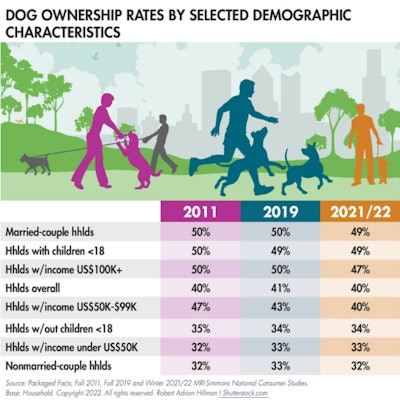
In the wake of COVID-19, as Packaged Facts has recently reported in Petfood Industry magazine and at Petfood Forum 2022, a spike in dog ownership among upmarket consumers was offset by pet ownership attrition among less prosperous or more budget-conscious demographics.
This dynamic raises the question of whether and how COVID-19 impacts have altered the longstanding association between dog ownership and married-with-children households, and the relative importance of these household composition metrics compared with levels of household income.
Household demographics and dog ownership trends
Household income matters to dog ownership, of course, with pets being a discretionary expense and with dogs being the most expensive of mainstream pets to feed and care for. As shown by 2021/22 data from MRI-Simmons, therefore, 47% of households with an income of US$100,000 or more have dogs, compared with 40% of households overall and with 33% of households with an income of under US$50,000 (see Table 1).

However, being married and/or having children in the home matter more. That is, 49% of married households or households with kids under 18 at home have dogs, compared with 47% of the US$100K+ households. Conversely, while dog ownership drops to 33% among low-to-moderate earning households — those with a household income of less than $50,000 — rates drop a bit farther still to 32% among households without a married pair.
While the marriage factor may slightly edge out the presence of children in the home in terms of dog ownership rates, kids turn the table when it comes to growth in dog ownership demographics.
Overall, from 2011 to the present, the growth in the number of dog-owning households (a 4.65 million increase to 52.50 million) equates to 38% of the overall U.S. growth (see Table 2) in number of households (a 12.17 million jump to 130.76 million). In terms of dog-ownership trends over the last decade, numerical growth in married-couple dog-owning households merely matches this overall 38% ratio. That is, married-couple households aren’t increasing disproportionately as dog owners, and conversely neither are non-married-couple households decreasing disproportionately.

TABLE 2: The largest dog-owning segment in the U.S. can be found in households that make US$100,000 or more annually and have kids.
Fold in the upper-income factor, and the number of dog-owning US$100K+ households with kids in the home grew at a 56% ratio to the overall gain in number of U.S. households. Conversely, the number of dog-owning US$100K households without kids in the home grew at only a 29% ratio to the overall numerical gain in households, or half the ratio as their economic counterparts with kids at home.
Looking at growth trends for dog ownership, therefore, money matters more than marriage, but kids matter more than money, and having money and kids matters most.
For more on Packaged Facts pet market and pet population reports

















